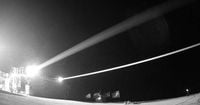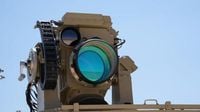On September 17, 2025, Israel’s Ministry of Defense announced a watershed moment in military technology: the completion of final tests and operational readiness of the Iron Beam, a high-powered laser air defense system designed to intercept rockets, mortars, drones, and aircraft. The news, confirmed by both the ministry and defense contractor Rafael Advanced Defense Systems, marks not just the end of a decade-long development process but also the dawn of a new era in missile defense—one that promises to reshape both Israel’s security landscape and the broader calculus of modern warfare.
The Iron Beam system, also known in Hebrew as Or Eitan (Eitan’s Light), is set to be delivered to the Israel Defense Forces (IDF) by the end of this year. This milestone followed several weeks of rigorous operational trials in southern Israel, conducted by the Directorate of Defense Research & Development (DDR&D) in partnership with the Israeli Air Force and Rafael. According to Reuters, these tests demonstrated the system’s ability to intercept a broad range of aerial threats, including rockets, mortars, and unmanned aerial vehicles, under diverse operational scenarios.
“This is the first time in the world that a high-power laser interception system has reached full operational maturity,” said Defense Ministry Director-General Amir Baram, as quoted by Reuters. The ministry described Iron Beam as a “global technological and engineering breakthrough,” and officials have hailed it as a potential “game-changer” in the ongoing battle against projectile attacks.
Iron Beam’s operational debut comes at a particularly fraught moment for Israel. The announcement coincides with an expanded offensive in Gaza City and ongoing confrontations with Iranian-backed Houthis in Yemen, as well as persistent threats from Hezbollah in Lebanon. The timing is not lost on Israeli leaders. Defense Minister Israel Katz declared, “It places the State of Israel at the forefront of global military technology and makes Israel the first nation to possess this capability.” Katz added, “Our enemies from Gaza, Iran, Lebanon, Yemen, and other arenas should know: just as we are strong in defense, we are strong in offense – and we will do everything to protect the security of Israeli citizens.”
The system’s Hebrew name, Or Eitan, carries a poignant significance. It was renamed from Magen Or (Light Shield) in memory of Captain Eitan Oster, a 22-year-old commander in the IDF’s Egoz Commando Unit who was killed fighting Hezbollah in southern Lebanon in October 2024. Oster’s father, an engineer with DDR&D, was one of the initiators and developers of the Iron Beam project. In a symbolic gesture, the ministry said, “The system’s Hebrew name has been changed from Magen Or (Light Shield) to Or Eitan (Eitan’s Light), in memory of Cpt. Eitan Oster.”
Iron Beam is designed to function as an integral part of Israel’s multi-layered air defense network, complementing existing systems such as Iron Dome, David’s Sling, and the Arrow family of interceptors. While the Iron Dome is renowned for its effectiveness against short-range threats and has been improved to counter UAVs and cruise missiles, it relies on kinetic interceptors that can cost at least $50,000 per shot. In stark contrast, the Iron Beam’s laser-based interceptions cost only a few dollars each, thanks to the negligible marginal cost of directed-energy technology. As reported by Breaking Defense, “The marginal cost of a laser interception, estimated at less than several dollars, will lower the burden of cost on Israel’s air defenses.”
This dramatic shift in the economics of air defense is not merely theoretical. Developers emphasized that while the system’s upfront investment is substantial, the long-term savings are expected to be immense. “Despite the high upfront investment, the economics are overwhelmingly favorable in the long run, as the system is expected to ‘break’ the cost equation of air defense and render interception costs negligible,” developers told Israel Hayom.
The Iron Beam is ground-based and boasts a range of around ten kilometers, with the ability to “burn or fry objects” in mere seconds, according to defense officials. Its advanced targeting mechanism—built on Rafael’s proprietary adaptive optics technology—ensures a stable, focused, and accurate energy beam, allowing it to engage multiple threats simultaneously, even during heavy barrages. “Rafael’s laser system, built on our proprietary adaptive optics technology, will undoubtedly be a game-changing system with unprecedented impact on modern warfare,” said Rafael Chairman Yuval Steinitz, as cited by Reuters.
One of the most significant advantages of Iron Beam is its ability to supplement, not replace, Israel’s current air defense systems. It is tailored to deal with smaller, short-range threats—such as mortars and drones—leaving larger, more complex threats for the kinetic interceptors of David’s Sling and Arrow. The system is designed to integrate seamlessly with Iron Dome batteries and their command and control infrastructure. “Initially, it will be operated from Iron Dome’s existing command and control units,” Israel Hayom reported.
However, laser-based defenses are not without their limitations. The main downside is that performance can be affected by adverse weather conditions, such as heavy cloud cover or fog. Despite this, developers assert that Iron Beam will remain operational about 90% of the time and is meant to complement, rather than replace, kinetic systems. “The system would remain operational about 90% of the time, and in any case, it is meant to complement Iron Dome and Israel’s other air defense systems,” wrote Israel Hayom.
Iron Beam’s journey to operational readiness has been a long one. The project was first unveiled in 2014 and has undergone more than a decade of development, with production beginning over two years ago. Elbit Systems, acting as a key subcontractor, has also contributed to the project and is working on airborne versions of high-power lasers, which could further extend Israel’s defensive reach. According to Elbit CEO Bezhalel Machlis, “First and foremost an airborne laser that holds the potential for a strategic change in air defense capabilities,” is in development, as reported by Reuters.
During the current war, a lower-powered version of Iron Beam was already pressed into action by the IDF, reportedly shooting down 35 Hezbollah drones launched from Lebanon. Rafael has also showcased several variants of its high-energy laser weapon systems, including the Iron Beam 450 (an upgraded version), Iron Beam M (a compact, mobile variant), and Lite Beam (a lightweight model for armored vehicles). A maritime version is also in the works for deployment on Navy vessels.
With the Iron Beam declared operational and its first batteries set to be absorbed into the IDF by the end of 2025, Israel’s air defense network stands on the cusp of a significant transformation. As the Defense Ministry declared, “A significant leap in the operational capabilities of the Air Defense Array is expected, through the long-range laser weapon system.”
For Israel, the completion and deployment of Iron Beam is more than just a technological leap—it’s a statement of resilience, innovation, and a profound commitment to national security, even as the nation faces threats on multiple fronts.



